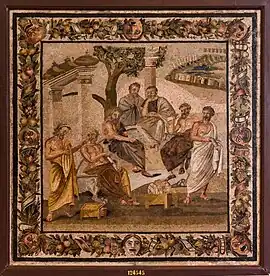| The School of Athens | |
|---|---|
 | |
| Artist | Raphael |
| Year | 1509–1511 |
| Type | Fresco |
| Dimensions | 500 cm × 770 cm (200 in × 300 in) |
| Location | Apostolic Palace, Vatican City |
The School of Athens (Italian: Scuola di Atene) is a fresco by the Italian Renaissance artist Raphael. The fresco was painted between 1509 and 1511 as a part of Raphael's commission to decorate the rooms now known as the Stanze di Raffaello, in the Apostolic Palace in the Vatican. It depicts a congregation of philosophers, mathematicians, and scientists from Ancient Greece, including Plato, Aristotle, Pythagoras, Archimedes, Heraclitus and Zarathustra the Iranian prophet. The Italian artists Leonardo da Vinci and Michelangelo are also featured in the painting, shown as Plato and Heraclitus respectively.
The painting notably features accurate perspective projection, a defining characteristic of the Renaissance era. Raphael learned perspective from Leonardo, whose role as Plato is central in the painting. The themes of the painting, such as the rebirth of Ancient Greek philosophy and culture in Europe (along with Raphael's work) were inspired by Leonardo's individual pursuits in theatre, engineering, optics, geometry, physiology, anatomy, history, architecture and art.[1]
The School of Athens is regarded as one of Raphael's best known works, and has been described as "Raphael's masterpiece and the perfect embodiment of the classical spirit of the Renaissance".[2]
Program, subject, figure identifications and interpretations

The Stanza della Segnatura was the first of the rooms to be decorated, and The School of Athens, representing philosophy, is believed to be the third painting to be finished there, after La Disputa (Theology) on the opposite wall, and the Parnassus (Literature).[3]
The School of Athens is one of a group of four main frescoes on the walls of the Stanza (those on either side centrally interrupted by windows) that depict distinct branches of knowledge. Each theme is identified above by a separate tondo containing a majestic female figure seated in the clouds, with putti bearing the phrases: "Seek Knowledge of Causes", "Divine Inspiration", "Knowledge of Things Divine" (Disputa), "To Each What Is Due". Accordingly, the figures on the walls below exemplify philosophy, poetry (including music), theology, and justice.[4][5] The traditional title is not Raphael's. The subject of the painting is actually philosophy, or at least ancient Greek philosophy, and its overhead tondo-label, "Causarum Cognitio", tells us what kind, as it appears to echo Aristotle's emphasis on wisdom as knowing why, hence knowing the causes, in Metaphysics Book I and Physics Book II. Indeed, Plato and Aristotle appear to be the central figures in the scene. However, many of the philosophers depicted sought knowledge of first causes. Many lived before Plato and Aristotle, and hardly a third were Athenians. The architecture contains Roman elements, but the general semi-circular setting having Plato and Aristotle at its centre might be alluding to Pythagoras' monad.

Commentators have suggested that nearly every great ancient Greek philosopher can be found in the painting, but determining which are depicted is speculative, since Raphael made no designations outside possible likenesses, and no contemporary documents explain the painting. Compounding the problem, Raphael had to invent a system of iconography to allude to various figures for whom there were no traditional visual types. For example, while the Socrates figure is immediately recognizable from Classical busts, one of the figures alleged to be Epicurus is far removed from his standard depiction.
Aspects of the fresco other than the identities of the figures have also been variously interpreted, but few such interpretations are unanimously accepted among scholars. That the rhetorical gestures of Plato and Aristotle are kinds of pointing (to the heavens, and down to earth) is popularly accepted as likely. However, Plato's Timaeus – which is the book Raphael places in his hand – was a sophisticated treatment of space, time, and change, including the Earth, which guided mathematical sciences for over a millennium. Aristotle, with his four-elements theory, held that all change on Earth was owing to motions of the heavens. In the painting Aristotle carries his Ethics, which he denied could be reduced to a mathematical science. It is not certain how much the young Raphael knew of ancient philosophy, what guidance he might have had from people such as Bramante and whether a detailed program was dictated by his sponsor, Pope Julius II.
Nevertheless, the fresco has even recently been interpreted as an exhortation to philosophy and, in a deeper way, as a visual representation of the role of Love in elevating people toward upper knowledge, largely in consonance with contemporary theories of Marsilio Ficino and other neo-Platonic thinkers linked to Raphael.[6]
Finally, according to Giorgio Vasari, the scene includes Raphael himself, the Duke of Mantua, Zoroaster and some Evangelists.[7]
However, to Heinrich Wölfflin, "it is quite wrong to attempt interpretations of the School of Athens as an esoteric treatise ... The all-important thing was the artistic motive which expressed a physical or spiritual state, and the name of the person was a matter of indifference" in Raphael's time.[8] Raphael's artistry then orchestrates a beautiful space, continuous with that of viewers in the Stanza, in which a great variety of human figures, each one expressing "mental states by physical actions", interact, in a "polyphony" unlike anything in earlier art, in the ongoing dialogue of Philosophy.[9]
An interpretation of the fresco relating to hidden symmetries of the figures and the star constructed by Bramante was given by Guerino Mazzola and collaborators.[10] The main basis are two mirrored triangles on the drawing from Bramante (Euclid), which correspond to the feet positions of certain figures.[11]
Paolo Zamboni, professor of vascular surgery at the University of Ferrara, made a medical study of the painting, noting that Raphael's depiction of Michelangelo, in the role of Heraclitus, shows varicose veins in the legs.[12]
Figures
The identities of some of the philosophers in the picture, such as Plato and Aristotle, are certain. Beyond that, identifications of Raphael's figures have always been hypothetical. To complicate matters, beginning from Vasari's efforts, some have received multiple identifications, not only as ancients but also as figures contemporary with Raphael. Vasari mentions portraits of the young Federico II Gonzaga, Duke of Mantua, leaning over Bramante with his hands raised near the bottom right, and Raphael himself.[13]
Central figures (14 and 15)
In the center of the fresco, at its architecture's central vanishing point, are the two undisputed main subjects: Plato on the left and Aristotle, his student, on the right. Both figures hold contemporary (of the time), bound copies of their books in their left hands, while gesturing with their right. Plato holds Timaeus and Aristotle holds his Nicomachean Ethics. Plato is depicted as old, grey, and bare-foot. By contrast, Aristotle, slightly ahead of him, is in mature manhood, wearing sandals and gold-trimmed robes, and the youth about them seem to look his way. In addition, these two central figures gesture along different dimensions: Plato vertically, upward along the picture-plane, into the vault above; Aristotle on the horizontal plane at right-angles to the picture-plane (hence in strong foreshortening), initiating a flow of space toward viewers.
It is popularly thought that their gestures indicate central aspects of their philosophies, for Plato, his Theory of Forms, and for Aristotle, an emphasis on concrete particulars. Many interpret the painting to show a divergence of the two philosophical schools. Plato argues a sense of timelessness whilst Aristotle looks into the physicality of life and the present realm.
Setting

The building is in the shape of a Greek cross, which some have suggested was intended to show a harmony between pagan philosophy and Christian theology[2] (see Christianity and Paganism and Christian philosophy). The architecture of the building was inspired by the work of Bramante, who, according to Vasari, helped Raphael with the architecture in the picture.[2] The resulting architecture was similar to the then new St. Peter's Basilica.[2]
There are two sculptures in the background. The one on the left is the god Apollo, god of light, archery and music, holding a lyre.[2] The sculpture on the right is Athena, goddess of wisdom, in her Roman guise as Minerva.[2]
The main arch, above the characters, shows a meander (also known as a Greek fret or Greek key design), a design using continuous lines that repeat in a "series of rectangular bends" which originated on pottery of the Greek Geometric period and then became widely used in ancient Greek architectural friezes.[14]
Drawings and cartoon
A number of drawings made by Raphael as studies for the School of Athens are extant.[15] A study for the Diogenes is in the Städel in Frankfurt[16] while a study for the group around Pythagoras, in the lower left of the painting, is preserved in the Albertina Museum in Vienna.[17] Several drawings, showing the two men talking while walking up the steps on the right and the Medusa on Athena's shield,[18][lower-alpha 1] the statue of Athena (Minerva) and three other statues,[20] a study for the combat scene in the relief below Apollo[21] and "Euclid" teaching his pupils[22] are in the Ashmolean Museum of Art and Archaeology at the University of Oxford.
The cartoon for the painting is in the Pinacoteca Ambrosiana in Milan.[23] Missing from it is the architectural background, the figures of Heraclitus, Raphael, and Protogenes. The group of the philosophers in the left foreground strongly recall figures from Leonardo's Adoration of the Magi.[24] Additionally, there are some engravings of the scene's sculptures by Marcantonio Raimondi; they may have been based on lost drawings by Raphael, as they do not match the fresco exactly.[25]
Copies
The Victoria and Albert Museum in London has a rectangular copy over 4 metres by 8 metres in size, painted on canvas, dated 1755 by Anton Raphael Mengs, on display in the eastern Cast Court.[26]
Modern reproductions of the fresco abound. For example, a full-size one can be seen in the auditorium of Old Cabell Hall at the University of Virginia. Produced in 1902 by George W. Breck to replace an older reproduction that was destroyed in a fire in 1895, it is four inches off scale from the original, because the Vatican would not allow identical reproductions of its art works.[27]
A 1689 tapestry reproduction by the Gobelins Manufactory and commissioned by Louis XIV hangs above the presiding officer's platform in the French National Assembly chamber.[28] It had been removed in 2017 for a three-year restoration process undertaken by the Mobilier National, which manages Gobelins Manufactory.
Other reproductions include: in Königsberg Cathedral, Kaliningrad by Neide,[29] in the University of North Carolina at Asheville's Highsmith University Student Union, and a recent one in the seminar room at Baylor University's Brooks College. A copy of Raphael's School of Athens was painted on the wall of the ceremonial stairwell that leads to the famous, main-floor reading room of the Sainte-Geneviève Library in Paris.
The two figures to the left of Plotinus were used as part of the cover art of both Use Your Illusion I and II albums of Guns N' Roses.
Precursors
Similar subjects are known from antiquity, notably the Plato's Academy mosaic. It perhaps also appeared in two groups of statues from Roman Egypt. The 19th century French consul Jean-François Mimaut mentioned nine statues at the Serapeum of Alexandria holding rolls, while eleven statues were found at the Memphis Saqqara. A review of "Les Statues Ptolémaïques du Sarapieion de Memphis" ascribed them to the 3rd century, sculpted of limestone and stucco, some standing and others sitting. Rowe and Rees 1956 suggested that both statue groups share a similar subject to the Plato's Academy mosaic, with the Saqqara figures identified as: "(1) Pindare, (2) Démétrios de Phalère, (3) x (?), (4) Orphée (?) aux oiseaux,[30] (5) Hésiode, (6) Homère, (7) x (?), (8) Protagoras, (9) Thalès, (10) Héraclite, (11) Platon, (12) Aristote (?)."[31][32] However, there have been other suggestions (e.g. Mattusch 2008). Plato and Thales are commonly identified as central figures.[33]
Gallery



 Pythagoras and Archimedes
Pythagoras and Archimedes Archimedes displaying his Principle.
Archimedes displaying his Principle.
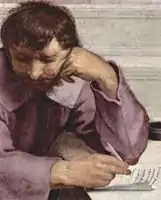
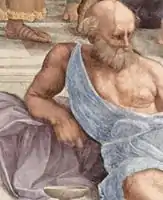
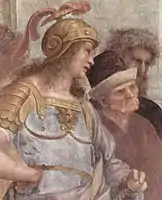
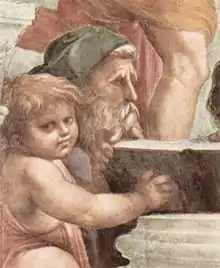 Possibly Zeno of Citium
Possibly Zeno of Citium
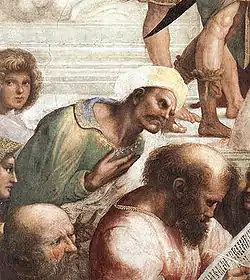 Averroes and Pythagoras
Averroes and Pythagoras Possibly Epicurus or Democritus
Possibly Epicurus or Democritus
See also
- List of paintings by Raphael
- The Last Supper by Leonardo da Vinci
References
Notes
- ↑ Possibly derived from a figure in Leonardo's Battle of Anghiari.[19]
Citations
- ↑ Georg Rainer Hofmann (1990). "Who invented ray tracing?". The Visual Computer. 6 (3): 120–124. doi:10.1007/BF01911003. S2CID 26348610..
- 1 2 3 4 5 6 History of Art: The Western Tradition by Horst Woldemar Janson, Anthony F. Janson (2004).
- ↑ Jones and Penny, p. 74: "The execution of the School of Athens ... probably followed that of the Parnassus."
- ↑ See Giorgio Vasari, "Raphael of Urbino", in Lives of the Artists, vol. I: "In each of the four circles he made an allegorical figure to point the significance of the scene beneath, towards which it turns. For the first, where he had painted philosophy, astrology, geometry and poetry agreeing with theology, is a woman representing knowledge, seated in a chair supported on either side by a goddess Cybele, with the numerous breasts ascribed by the ancients to Diana Polymastes. Her garment is of four colours, representing the four elements, her head being the colour of fire, her bust that of air, her thighs that of earth, and her legs that of water." For further clarification, and introduction to more subtle interpretations, see E. H. Gombrich, "Raphael's Stanza della Segnatura and the Nature of Its Symbolism", in Symbolic Images: Studies in the Art of the Renaissance (London: Phaidon, 1975).
- ↑ "To each what is due (jus suum cuique)" quotes from the definition of justice in Justinian, Institutes, book 1. See Anonymous (1840). "Review of J. D. Passavant, Rafael von Urbino und sein Vater Giovanni Santi". The Quarterly Review. 66: 1 at 29.
- ↑ M. Smolizza, Rafael y el Amor. La Escuela de Atenas como protréptico a la filosofia, in 'Idea y Sentimiento. Itinerarios por el dibujo de Rafael a Cézanne', Barcelona, 2007, pp. 29–77. [A review of the main interpretations proposed in the last two centuries.]
- ↑ According to Vasari, "Raphael received a hearty welcome from Pope Julius, and in the chamber of the Segnatura he painted the theologians reconciling Philosophy and Astrology with Theology, including portraits of all the wise men of the world in dispute."
- ↑ Wōlfflin, p. 88.
- ↑ Wōlfflin, pp. 94ff.
- ↑ Guerino Mazzola; et al. (1986). Rasterbild - Bildraster. Springer-Verlag. ISBN 978-3-540-17267-3.
- ↑ This can be seen here.
- ↑ "Diagnosi su tela: le grandi malattie dipinte dei pittori del passato". 27 June 2020.
- ↑ Giorgio Vasari, Lives of the Artists, v. I, sel. & transl. by George Bull (London: Penguin, 1965), p. 292.
- ↑ Lyttleton, Margaret. "Meander." Grove Art Online. Oxford University Press, 2012. Accessed 5 August 2012.
- ↑ Luitpold Dussler: Raphael. A Critical Catalogue (London and New York: Phaidon 1971), p. 74
- ↑ Zeichnungen – 16. Jahrhundert – Graphische Sammlung – Sammlung – Städel Museum Archived 2012-03-08 at the Wayback Machine. Staedelmuseum.de (2010-11-18). Retrieved on 2011-06-13.
- ↑ Raffaello Santi. mit seinen Schülern (Studie für die "Schule von Athen", Stanza della Segnatura, Vatikan) (trans.: Pythagoras and his students (Study for the 'School of Athens', Stanza della Signatura, the Vatican) (inventory number 4883)). Albertina Museum. Vienna, Austria, 2008. Retrieved on 2011-06-13.
- ↑ "Two Men conversing on a Flight of Steps, and a Head shouting". Ashmolean Museum of Art and Archaeology. University of Oxford. 2011. Archived from the original on 28 June 2011. Retrieved 13 June 2011.
- ↑ Salmi, Mario; Becherucci, Luisa; Marabottini, Alessandro; Tempesti, Anna Forlani; Marchini, Giuseppe; Becatti, Giovanni; Castagnoli, Ferdinando; Golzio, Vincenzo (1969). The Complete Work of Raphael. New York: Reynal and Co., William Morrow and Company. p. 378.
- ↑ "Studies for a Figure of Minerva and Other Statues". Ashmolean Museum of Art and Archaeology. University of Oxford. 2011. Archived from the original on 28 June 2011. Retrieved 13 June 2011.
- ↑ "Recto: Combat of nude men". Ashmolean Museum of Art and Archaeology. University of Oxford. 2011. Archived from the original on 28 June 2011. Retrieved 13 June 2011.
- ↑ Raphael (1482-1520).Euclid instructing his Pupils. Ashmolean Museum of Art and Archaeology, University of Oxford, 2011. Retrieved on 2011-06-13.
- ↑ School of Athens Cartoon
- ↑ Salmi, Mario; Becherucci, Luisa; Marabottini, Alessandro; Tempesti, Anna Forlani; Marchini, Giuseppe; Becatti, Giovanni; Castagnoli, Ferdinando; Golzio, Vincenzo (1969). The Complete Work of Raphael. New York: Reynal and Co., William Morrow and Company. p. 379.
- ↑ Salmi, Mario; Becherucci, Luisa; Marabottini, Alessandro; Tempesti, Anna Forlani; Marchini, Giuseppe; Becatti, Giovanni; Castagnoli, Ferdinando; Golzio, Vincenzo (1969). The Complete Work of Raphael. New York: Reynal and Co., William Morrow and Company. pp. 377, 422.
- ↑ V&A Museum: Copy of Raphael's School of Athens in the Vatican. collections.vam.ac.uk (2009-08-25). Retrieved on 2016-03-24.
- ↑ Information on Old Cabell Hall from University of Virginia
- ↑ "La restauration de la tapisserie de l'École d'Athènes - Patrimoine - Assemblée nationale". www2.assemblee-nationale.fr. Retrieved 2022-01-21.
- ↑ Northern Germany: As Far as the Bavarian and Austrian Frontiers, Baedeker, 1890, p. 247.
- ↑ French for to birds.
- ↑ Alan Rowe; B. R. Rees (1956). "A Contribution To The Archaeology of The Western Desert: IV - The Great Serapeum Of Alexandria" (PDF). Manchester.
- ↑ Ph. Lauer; Ch. Picard (1957). "Reviewed Work: Les Statues Ptolémaïques du Sarapieion de Memphis". Archaeological Institute of America. 61 (2): 211–215. doi:10.2307/500375. JSTOR 500375.
- ↑ Katherine Joplin (2011). "Plato's Circle in the Mosaic of Pompeii". Electrum Magazine.
- ↑ John Douglas Holgate, "Codes and Messages in Raphael's 'School of Athens'" 2016 https://www.researchgate.net/publication/306398440_Codes_and_Messages_in_Raphael's_'School_of_Athens'
Sources
- Roger Jones and Nicholas Penny, Raphael, Yale, 1983, ISBN 0300030614.
- Heinrich Wölfflin, Classic Art: An Introduction to the Italian Renaissance (London: Phaidon, 2d edn. 1953).
Further reading
- Kleiner, Fred S. (2009). Gardner's Art through the Ages: The Western Perspective, Volume II. Cengage Learning. pp. 363–365. ISBN 978-0-495-57364-7.
- Henry Keazor: Raffaels „Schule von Athen“. Von der Philosophenakademie zur Hall of Fame, Berlin 2021, ISBN 978-3-8031-3695-4.
- Gertrude Garrigues, "Raphael's 'School of Athens'", The Journal of Speculative Philosophy Vol. 13, No. 4 (October, 1879), pp. 406–420.
External links
- The School of Athens on In Our Time at the BBC
- The School of Athens at the Web Gallery of Art
- The School of Athens (interactive map)
- Cartoon of The School of Athens
- The School of Athens reproduction at UNC Asheville
- BBC Radio 4 discussion about the significance of this picture in the programme In Our Time with Melvyn Bragg.
- 3 Cool Things You Might Not Know About Raphael's School of Athens
- The School of Athens in Britannnica.
 Media related to The School of Athens at Wikimedia Commons
Media related to The School of Athens at Wikimedia Commons


